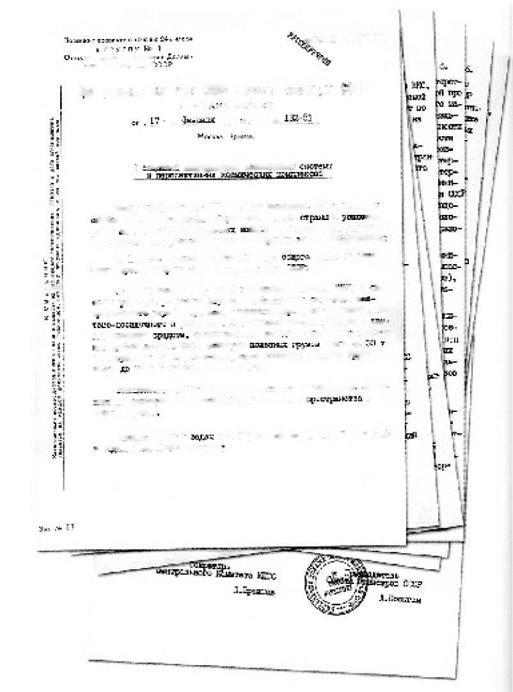THE OFFICIAL GO-AHEAD
The decree (nr. 123-51) was finally issued by the Central Committee of the Soviet Communist Party and the Council of Ministers of the USSR on 17 February 1976 and called “On the Development of a Reusable Space System and Future Space Complexes’’. In the typical style of those days, the official go-ahead for the Soviet shuttle was literally worded as follows:
“The Central Committee of the Soviet Communist Party and the Council of Ministers, attaching special importance to increasing the defense capabilities of the country and strengthening the work to create future space complexes for solving military, economic, and scientific tasks, has decided: (1) to accept the proposals of the Ministry of General Machine Building, the Ministry of Defense of the USSR, and the Academy of Sciences of the USSR to create a Reusable Space System consisting of a rocket boost stage, an orbital plane, an interorbital tug, a complex to control the system, launch, landing and repair complexes, and other ground-based means to launch into northeasterly orbits with an altitude of 200 kilometers payloads weighing up to 30 tons and return to the launch and landing complex payloads weighing up to 20 tons and with the purpose of:
– counteracting the measures taken by the likely adversary to expand the use of space for military purposes;
– solving purposeful tasks in the interests of defense, the national economy, and science;
– carrying out military and applications research and experiments in space to support the development of space battle systems using weapons based on known and new physical principles;
|
|
|
|
 |
|
|
|
 |
|
|
|
|
|
|


– putting into near-Earth orbits, servicing in these orbits, and returning to Earth space vehicles for different purposes, delivering to space stations cosmonauts and cargo and returning them back to Earth..[25].
Underscoring the military motives for developing the Soviet shuttle, the decree placed the Ministry of Defense in charge of determining the system’s specifications. MOM was assigned as the lead ministry to develop the shuttle and associated space weaponry. MAP was tasked with developing the orbiter’s airframe as well as building the runway and its associated equipment and the carrier aircraft to ferry the orbiter to the launch site.
Not surprisingly, Glushko’s NPO Energiya became the lead organization for the shuttle under MOM, performing a role similar to that of a “prime contractor’’ in the West. Igor Sadovskiy remained the system’s chief designer. The choice of an organization within MAP was less obvious. Probably, the most logical choice would have been MMZ Zenit’s space branch in Dubna (now part of DPKO Raduga), which had been working on the Spiral project for a decade. However, MAP minister Pyotr Dementyev decided to set up a new organization called NPO Molniya, which was an amalgam of three existing design bureaus: MKB Molniya, MKB Burevestnik, and Myasishchev’s Experimental Machine Building Factory (EMZ). Only EMZ had earlier experience with spaceplane projects, having proposed a futuristic single – stage-to-orbit spaceplane called M-19 in response to the Space Shuttle (see Chapter 9). Given the limited background of the three organizations in space-related work, some leading specialists of MMZ Zenit and the Dubna space branch were transferred to NPO Molniya to occupy the leading positions. These included Spiral chief designer Gleb Lozino-Lozinskiy, who was placed in charge of the new organization, and his deputy Gennadiy Dementyev, the son of the MAP minister. NPO Molniya was officially created on the basis of MAP orders dated 24 February and 15 March 1976 (see Chapter 4) [26].
The decree was not just restricted to the Soviet shuttle, it also sanctioned the development of multimodular space stations (what would eventually become Mir), a new type of Soyuz ship to transport cosmonauts to those stations (what later became Soyuz-T) as well as a system of geostationary data relay satellites called GKKRS (Global Space Command-Relay System) (what would eventually become Geyzer and Luch/Altair). Surprisingly, it also ordered NPO Energiya to work out a preliminary design in 1976-1978 for a “Lunar Expeditionary Complex’’ in 1976-1978, essentially a continuation of the Zvezda work begun in the middle of 1974. However, the project does not seem to have received much support and was closed down by a commission headed by Keldysh in 1978 [27]. In a final attempt to keep his lunar aspirations alive, Glushko tabled a proposal for a more modest manned lunar project using the Energiya rocket, but this never saw the light of day either [28].
However, if any Soviet cosmonauts were going to the Moon anytime soon, it was certainly not going to be on the N-1. With work on the ill-fated Moon rocket already suspended in 1974, the decree now officially terminated all work on the N-1/L-3 project, although it did call for using the N-1’s cosmodrome infrastructure to the maximum extent possible.
Official approval of the Soviet shuttle came more than four years after President Nixon’s Space Shuttle decision. In some ways this slow response was reminiscent of the Soviets’ 1964 decision to go to the Moon, which was made more than three years after President Kennedy’s announcement of the Apollo program. The official history of NPO Energiya gives both political and strategic motives for the decision:
on the one hand [the Reusable Space System] was to consolidate the leading position of the USSR in the exploration of space and on the other hand [it] was to exclude the possible technical and military [advantage], connected with the appearance among the potential enemy of the… Space Shuttle, a principally new technical means of delivering to near-Earth orbit and returning to Earth payloads of significant masses’’ [29].
While national prestige certainly played a role in the Buran decision, it was not as dominant as it had been in the Moon race. For one, there was no intention to upstage the US Space Shuttle. The maiden flight of the Soviet shuttle was planned for no earlier than 1983, which was four years later than the expected launch date of the first Space Shuttle. Clearly, the driving force behind Buran was the urge to maintain strategic parity with the United States. As far as the Russians were concerned, Buran was just another part of the Cold War. Another government/party decree in 1976 ordered NPO Energiya to begin studies of space-based weapons “for combat operations in and from space’’, in which the new heavy-lift launch vehicles and the shuttle would play a crucial role (see Chapter 6).
This is not to say there was unanimous support for the project among the military. The payloads for the shuttle and the super-heavy boosters derived from it were not clearly defined. With the benefit of hindsight, the official history of the Military Space Forces says:
“There was no well-founded need for the USSR Ministry of Defense [to develop] such a system. Buran’s main characteristics were close to those of the Space Shuttle and it had [the same] shortcomings, and moreover it was even less economical” [30].
Despite all the similarities, there was also a basic difference with the American Shuttle philosophy. The Space Shuttle was advocated as a system that would replace all existing expendable launch vehicles and launch all types of payloads (both government and commercial), a decision for which NASA had to pay dearly after the Challenger disaster in 1986. The Soviet shuttle was never intended to be a substitute for expendable launch vehicles, but a system that would be used exclusively for tasks that could not be handled by conventional rockets, such as the launch of heavy payloads and the maintenance and retrieval of satellites in orbit.










